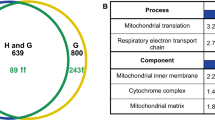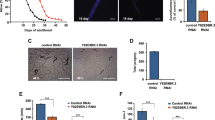Abstract
Yeast LAG1 was one of the first longevity genes found. Subsequent analysis showed that it encodes a component of ceramide synthase. Homologs of LAG1 have been identified in all eukaryotes examined for their presence, and multiple homologs are the norm. In human and mouse, the LAG1 counterpart is called LASS1. The involvement of this gene in determining yeast replicative life span led us to ask whether longevity effects could be found in C. elegans. Extended longevity was seen when we used RNAi to decrease expression of the worm homolog of LAG1, termed hyl-1, for Homolog of Yeast Longevity gene. In contrast, neither deletion of the gene nor overexpression resulted in life extension. There was no evidence that hyl-1 interacts with the insulin/IGF-1 like signaling pathway to specify longevity or dauer formation, nor were effects on stress resistance detected. Gene expression of hyl-1 homologs was altered in the deletion mutant and by RNAi, showing distinct evidence for compensation at the transcript level. These regulatory changes may explain the subtle phenotypic effects found under the conditions studied here.



Similar content being viewed by others
Abbreviations
- IIL:
-
insulin/IGF-1 like
- IGF:
-
insulin-like growth factor 1
- RNAi:
-
RNA interference
- PCR:
-
poymerase chain reaction
References
Brenner S (1974) The genetics of Caenorhabditis elegans. Genetics 77(1):71–94
Burow ME, Weldon CB, Collins-Burow BM, Ramsey N, McKee A, Klippel A, McLachlan JA, Clejan S, Beckman BS (2000) Cross-talk between phosphatidylinositol 3-kinase and sphingomyelinase pathways as a mechanism for cell survival/death decisions. J Biol Chem 275(13):9628–9635
Clancy DJ, Gems D, Harshman LG, Oldham S, Stocker H, Hafen E, Leevers SJ, Partridge L (2001) Extension of life-span by loss of CHICO, a Drosophila insulin receptor substrate protein. Science 292:104–106
Cutler RG, Mattson MP (2001) Sphingomyelin and ceramide as regulators of development and lifespan. Mech Ageing Dev 122(9):895–908
de Castro E, Hegi de Castro S, Johnson TE (2004) Isolation of long-lived mutants in Caenorhabditis elegans using selection for resistance to juglone. Free Radic Biol Med 37(2):139–145
D’mello NP, Childress AM, Franklin DS, Kale SP, Pinswasdi C, Jazwinski SM (1994) Cloning and characterization of LAG1, a longevity-assurance gene in yeast. J Biol Chem 269:15451–15459
Echeverri CJ, Beachy PA, Baum B, Boutros M, Buchholz F, Chanda SK, Downward J, Ellenberg J, Fraser AG, Hacohen N, Hahn WC, Jackson AL, Kiger A, Linsley PS, Lum L, Ma Y, Mathey-Prevot B, Root DE, Sabatini DM, Taipale J, Perrimon N, Bernards R (2006) Minimizing the risk of reporting false positives in large-scale RNAi screens. Nat Methods 3(10):777–779
Egilmez NK, Chen JB, Jazwinski SM (1989) Specific alterations in transcript prevalence during the yeast life span. J Biol Chem 264:14312–14431
Fire A, Xu S, Montgomery MK, Kostas SA, Driver SE, Mello CC (1998) Potent and specific genetic interference by double-stranded RNA in Caenorhabditis elegans. Nature 391:806–811
Gorski J, Dobryn A, Zendzian-Piotrowska M (2002) The sphingomyelin-signaling pathway in skeletal muscles and its role in regulation of glucose uptake. Ann NY Acad Sci 967:236–248
Guillas I, Kirchman PA, Chuard R, Pfefferli M, Jiang JC, Jazwinski SM, Conzelmann A (2001) C26-CoA-dependent ceramide synthesis of Saccharomyces cerevisiae is operated by Lag1p and Lac1p. EMBO J 20(11):2655–2665
Henderson ST, Johnson TE (2001) daf-16 integrates developmental and environmental inputs to mediate aging in the nematode Caenorhabditis elegans. Curr Biol 11(24):1975–1980
Holzenberger M, Dupont J, Ducos B, Leneuve P, Geloen A, Even PC, Cervera P, Le Bouc Y (2003) IGF-1 receptor regulates lifespan and resistance to oxidative stress in mice. Nature 421:182–187
Jazwinski SM, Conzelmann A (2002) LAG1 puts the focus on ceramide signaling. Int J Biochem Cell Biol 34(11):1491–1495
Jiang JC, Kirchman PA, Zagulski M, Hunt J, Jazwinski SM (1998) Homologs of the yeast longevity gene LAG1 in Caenorhabditis elegans and human. Genome Res 8:1259–1272
Jiang JC, Kirchman PA, Allen M, Jazwinski SM (2004) Suppressor analysis points to the subtle role of the LAG1 ceramide synthase gene in determining yeast longevity. Exp Gerontol 39(7):999–1009
Johnson TE, Wood WB (1982) Genetic analysis of life-span in Caenorhabditis elegans. Proc Natl Acad Sci USA 79(21):6603–6607
Kageyama-Yahara N, Riezman H (2006) Transmembrane topology of ceramide synthase in yeast. Biochem J 398:585–593
Kamath RS, Ahringer J (2003) Genome-wide RNAi screening in Caenorhabditis elegans. Methods 30(4):313–321
Kenyon C (2005) The plasticity of aging: insights from long-lived mutants. Cell 120(4):449–460
Minois N, Frajnt M, Wilson C, Vaupel JW (2005) Advances in measuring lifespan in the yeast Saccharomyces cerevisiae. Proc Natl Acad Sci USA 102:402–406
Mizutani Y, Kihara A, Igarashi Y (2005) Mammalian Lass6 and its related family members regulate synthesis of specific ceramides. Biochem J 390:263–271
Murakami S, Johnson TE (1996) A genetic pathway conferring life extension and resistance to UV stress in Caenorhabditis elegans. Genetics 143(3):1207–1218
Obeid LM, Hannun YA (2003) Ceramide, stress, and a “LAG” in aging. Sci Aging Knowledge Environ 39:PE27
Olsen A, Vantipalli MC, Lithgow GJ (2006) Lifespan extension of Caenorhabditis elegans following repeated mild hormetic heat treatments. Biogerontology 7(4):221–230
Schorling S, Vallee B, Barz WP, Riezman H, Oesterhelt D (2001) Lag1p and Lac1p are essential for the Acyl-CoA dependent ceramide synthase reaction in Saccharomyces cerevisiae. Mol Biol Cell 12:3417–3427
Simmer F, Moorman C, van der Linden AM, Kuijk E, van den Berghe PV, Kamath RS, Fraser AG, Ahringer J, Plasterk RH (2003) Genome-wide RNAi of C. elegans using the hypersensitive rrf-3 strain reveals novel gene functions. PLoS Biol 1(1):E12
Spassieva S, Seo JG, Jiang JC, Bielawdki J, Alvarez F, Jazwinski SM, Hannun YA, Obeid LM (2006) Necessary role for the Lag1p motif in (dihydro)ceramide synthase activity. J Biol Chem 281(45):33931–33938
Straczkowski M, Kowalska I, Nikolajuk A, Dzienis-Straczkowska S, Kinalska I, Baranowski M, Zendzian-Piotrowska M, Brzezinska Z, Gorski J (2004) Relationship between insulin sensitivity and sphingomyelin signaling pathway in human skeletal muscle. Diabetes 53(5):1215–1221
Stratford S, Hoehn KL, Liu F, Summers SA (2004) Regulation of insulin action by ceramide: dual mechanisms linking ceramide accumulation to the inhibition of Akt/protein kinase B. J Biol Chem 279(35):36608–36615
Teruel T, Hernandez R, Lorenzo M (2001) Ceramide mediates insulin resistance by tumor necrosis factor-alpha in brown adipocytes by maintaining Akt in an inactive dephosphorylated state. Diabetes 50(11):2563–2571
Venkataraman K, Futerman AH (2002) Do longevity assurance genes containing HOX domains regulate cell development via ceramide synthesis. FEBS Lett 528:3–4
Ventura N, Rea SL (2007) Caenorhabditis elegans mitochondrial mutants as an investigative tool to study human neurodegenerative diseases associated with mitochondrial dysfunction. Biotechnol J 2(5):584–595
Walker GA, White TM, McColl G, Jenkins NL, Babich S, Candido EP, Johnson TE, Lithgow GJ (2001) Heat shock protein accumulation is upregulated in a long-lived mutant of Caenorhabditis elegans. J Gerontol A Biol Sci Med Sci 56(7):B281–B287
Acknowledgments
This work was supported by grants from the National Institutes of Health (NIH), AG16219 to T.E.J. and AG006168 to S.M.J. Some nematode strains were provided by the Caenorhabditis Genetics Center which is funded by the National Center for Research Resources (NCRR) of the NIH. We would like to thank Heather Greer, Sarah Hegi, Ibett Hynek, and Chris Link for technical help and Lina Obeid for permission to cite her unpublished work. Address correspondence to Thomas E. Johnson, PhD, Institute for Behavioral Genetics, Campus Box 447, University of Colorado, Boulder, CO 80309.
Author information
Authors and Affiliations
Corresponding author
About this article
Cite this article
Tedesco, P., Jiang, J., Wang, J. et al. Genetic analysis of hyl-1, the C. elegans homolog of LAG1/LASS1 . AGE 30, 43–52 (2008). https://doi.org/10.1007/s11357-008-9046-3
Received:
Accepted:
Published:
Issue Date:
DOI: https://doi.org/10.1007/s11357-008-9046-3




